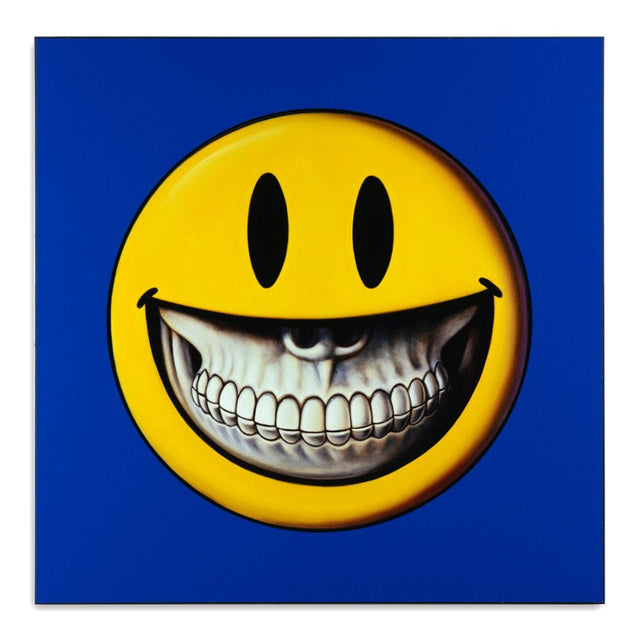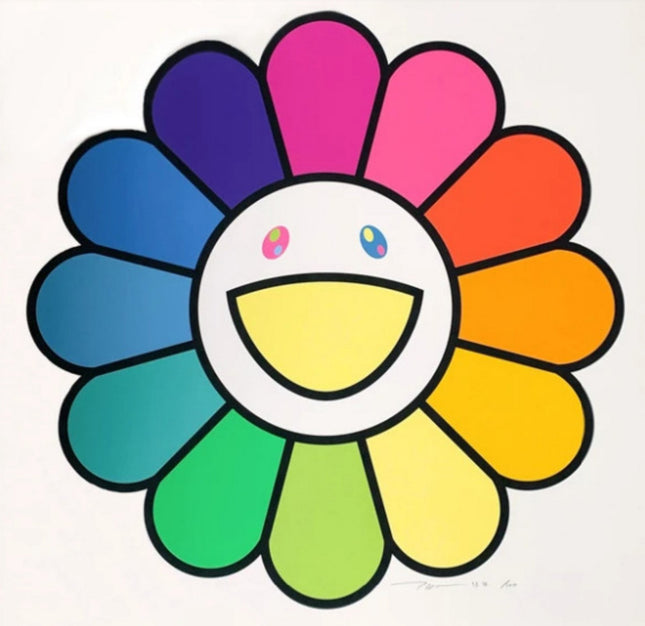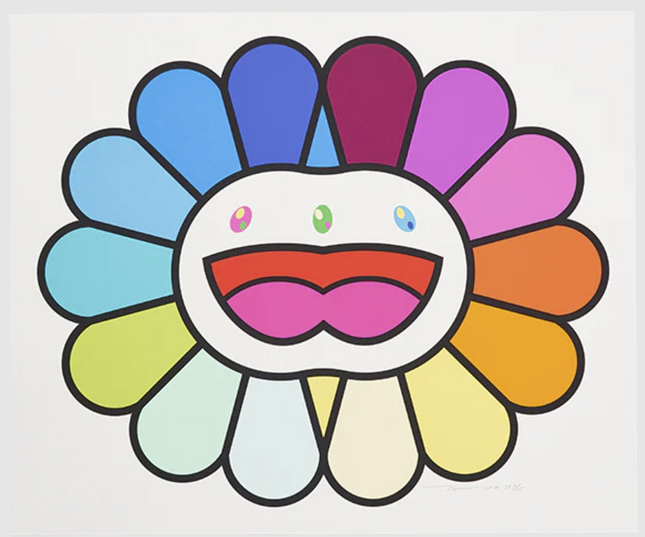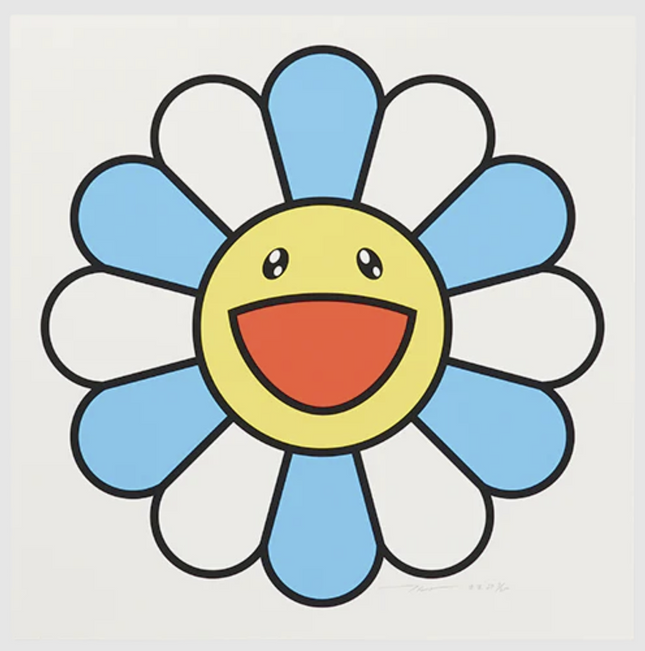
Smiley Face
-

Takashi Murakami TM/KK Ms Rainbow Flower SP Silkscreen Print by Takashi Murakami TM/KK
Ms. Rainbow Flower- SP 13-Color Hand-Pulled Limited Edition Silkscreen Print on Fine Art Paper by Takashi Murakami TM/KK Rare Street Art Famous Pop Artwork Artist. SP State Artist Proof 2020 Signed SP Edition of 25 Rare Takashi Murakami TM/KK Ms. Rainbow Flower Silkscreen Print Artwork 19.68x19.68in 50x50cm The Allure of Limited Editions in Street Pop Art: Takashi Murakami's Ms. Rainbow Flower Takashi Murakami's "Ms. Rainbow Flower- SP 13-Color Hand-Pulled Limited Edition Silkscreen Print on Fine Art Paper" vividly represents the symbiotic relationship between street pop art and limited edition prints. Takashi Murakami, a stalwart in the pop art movement, extends his canvas to street art, blurring the lines between commercial and high art. This piece, an Artist Proof (AP) from 2020, stands as a testament to Murakami's unique style that combines traditional Japanese aesthetics with contemporary pop culture, creating a colorful and optimistic depiction that resonates with pop art's ethos and street art's rawness. The work is part of an exclusive SP (Special Proof) edition of 25, highlighting the art market's rarity and desirability of limited editions. Artist Proofs are traditionally the first prints pulled from a run, kept aside due to their special status, and often marked by the artist's hand. Murakami's signature on "Ms. Rainbow Flower" authenticates the print and signifies its importance as a direct offspring of the artist's creative process. Each of the 13 colors is pulled by hand, a meticulous and labor-intensive process, which ensures that every print is imbued with a sense of individuality despite being part of a series. Takashi Murakami and His Influence on Modern Pop and Street Art Murakami's influence on modern pop and street art is substantial, with his art often characterized by its bright, explosive colors and incorporation of motifs from traditional and popular Japanese culture. His creation, "Ms. Rainbow Flower," with its cheerful persona and psychedelic hues, exemplifies 'Superflat'—a post-modern art movement pioneered by Murakami that flattens the image and merges the boundaries between different artistic genres. This particular piece, with its hand-pulled silkscreen technique, also pays homage to the methods of street art and graffiti, where the hand of the artist is central to the work's authenticity. At 19.68x19.68 inches (50x50cm), this silkscreen print is a collectible size, making it accessible to art enthusiasts and serious collectors. The edition size of 25 reinforces its rarity and elevates its status within the sphere of street pop art and graffiti artwork. Collectors of Murakami's work appreciate the visual appeal and the underlying commentary that the artist often embeds within his creations. Murakami's "Ms. Rainbow Flower" is not merely a decorative piece; it carries the weight of cultural symbols and the playfulness of pop art, infused with the artist's philosophical questions about the art world and its intersection with commerce. The Role of Limited Editions in Street Pop Art and Graffiti Artwork Limited edition prints like "Ms. Rainbow Flower" are crucial in disseminating street pop and graffiti artwork. They allow these traditionally ephemeral art forms to be preserved and appreciated over time. In the case of "Ms. Rainbow Flower," the limited edition run is particularly significant, as it represents a moment in Murakami's artistic journey, capturing the essence of his style during the year 2020. Owning such a piece means participating in the history of street pop art as it evolves from the streets and into the galleries and homes of art lovers. The Artist Proof status of this print positions it as a bridge between Murakami's archive and the public sphere. It underscores the intimate relationship between the artist and his work, offering insight into his process and the development of the final edition. For the artist, these proofs can function as a creative playground where they can experiment before the last series is completed. For the collector, they provide a piece of the artist's legacy, enriched with the potential of increased value over time due to their scarcity and the prestige associated with limited editions. In summary, Takashi Murakami's "Ms. Rainbow Flower- SP" is more than a mere representation of street pop art and graffiti artwork; it is a cultural artifact that encapsulates the spirit of its time and the artistic vision of one of contemporary art's most influential figures. Its existence as a limited edition print emphasizes the importance of rarity and artist interaction in art, offering collectors a chance to own a part of Murakami's expansive and colorful universe.
$5,468.00
-

Takashi Murakami TM/KK Multicolor Double Face White SP Silkscreen Print by Takashi Murakami TM/KK
Multicolor Double Face White SP 13-Color Hand-Pulled Limited Edition Silkscreen Print on Fine Art Paper by Takashi Murakami TM/KK Rare Street Art Famous Pop Artwork Artist. SP State Artist Proof 2020 Signed & Numbered Limited Edition of SP25 Artwork Size 23.3x19.68 Silkscreen of a Twin Merging At Center Multicolor Rainbow Flower Smiling Faces on White Background "Multicolor Double Face White SP" stands as a testament to the dynamism and evolution of contemporary art. Crafted by the internationally acclaimed artist, Takashi Murakami, this artwork showcases a 13-color hand-pulled limited edition silkscreen print on fine art paper, marking it as a distinctive and highly sought-after piece within the realm of modern art. Dating back to 2020, the art piece was meticulously developed as a State Artist Proof and boasts the exceptional detail and vibrancy that Murakami is renowned for. Emerging from the global conversations of pop and street art, Murakami’s piece bridges traditional Japanese art with the pulsating energy of contemporary graffiti. With a restricted edition of just SP25, each print is both signed and numbered, underscoring its rarity and significance. Spanning an impressive 23.3x19.68 inches, the silkscreen showcases a twin merging at the center, radiating with a multicolor rainbow. The symmetrical layout provides a harmonious balance, drawing the viewer into the very heart of the artwork where multicolored flower smiling faces stand out brilliantly against a pristine white backdrop. Murakami's distinct style has long been associated with reinventing the aesthetics of pop art, bringing forth fresh perspectives and methodologies. "Multicolor Double Face White SP" is no exception, marrying the playful and the profound in a visual spectacle. The artwork doesn’t merely represent the aesthetics of street art; it also encapsulates the essence of our times, highlighting the ever-blurring lines between genres, cultures, and mediums. Such pieces by Murakami not only solidify his standing as a vanguard of modern art but also challenge and inspire generations of artists and enthusiasts alike.
$5,198.00
-

Takashi Murakami TM/KK Sea Breeze Chan SP Silkscreen Print by Takashi Murakami TM/KK
Sea Breeze Chan Hand-Pulled Limited Edition Silkscreen Print on Fine Art Paper by Takashi Murakami TM/KK Rare Street Art Famous Pop Artwork Artist. SP State Artist Proof Signed 2020 Edition of 25 Rare Takashi Murakami TM/KK Ms. Mr Blue Teal Flower Silkscreen Print Artwork 19.68x19.68in 50x50cm Sea Breeze Chan by Takashi Murakami: Floral Iconography in Street Pop Art & Graffiti Artwork Sea Breeze Chan is a 2020 signed artist proof silkscreen print by Japanese contemporary artist Takashi Murakami, measuring 19.68 x 19.68 inches (50 x 50 cm). Produced in a rare edition of 25, this hand-pulled screen print features Murakami’s iconic smiling flower motif in a soft blue and white petal arrangement with a cheerful yellow face and bright red mouth. The print is executed on fine art paper with sharp black linework, even color fill, and meticulous print quality, aligning it with Murakami’s high production standards. The character, part of his extended Ms. Mr. Flower universe, radiates positivity and polished simplicity while functioning as a deeper symbol of Murakami’s engagement with emotion, cultural identity, and consumer-facing art. Within the world of Street Pop Art & Graffiti Artwork, Sea Breeze Chan stands as a distilled expression of controlled happiness and aesthetic perfection. Surface Clarity and Symbolic Subversion The character featured in Sea Breeze Chan is rendered with perfect symmetry and digital flatness, creating an illusion of emotional transparency. However, beneath its bright expression lies a commentary on the overload of joy in pop media and the visual language of consumerism. Murakami’s flower characters are often misread as decorative symbols, but their repetition and consistency echo the pressures of artificial happiness and the exhaustion of mass production. The use of limited palette—alternating blue and white petals—establishes rhythm and calm, while the bright red mouth and teardrop eyes evoke contrasting energy. In Street Pop Art & Graffiti Artwork, this kind of visual juxtaposition is critical, where familiar symbols are reprogrammed to expose the contradictions of public emotion and private reaction. Edition Format and Collectible Rarity This artist proof from the 2020 edition of 25 is marked by its SP state, signed and stamped by Takashi Murakami and released through TM/KK. Each print in this series was hand-pulled, maintaining the tactile integrity of traditional silkscreen technique while preserving the precision that defines Murakami’s Superflat ethos. The crisp lines and vibrant color are preserved on fine art paper designed to hold saturation and prevent warping, making the work suitable for high-end display. The square format reinforces balance, placing the flower dead center as an emblem of compositional control. Framing this work enhances its minimal visual power and situates it within the realm of collectible Street Pop Art & Graffiti Artwork that bridges gallery presence and popular cultural accessibility. Takashi Murakami’s Flower Legacy and Visual Language Takashi Murakami, born in Japan in 1962, is globally regarded as a key figure in contemporary art and Street Pop Art & Graffiti Artwork. His work is characterized by the Superflat concept—a collapsing of high and low culture, commercialism, and fine art. Murakami’s smiling flower has become a universal symbol, appearing on everything from Louis Vuitton collaborations to global exhibitions, but it always circles back to themes of loss, illusion, repetition, and longing. Sea Breeze Chan offers a serene, palette-specific variation that strips away excess and focuses on calm expression. It speaks in the visual language of perfection, but resonates with the emotional complexity of image culture. It is both a product and a portal—inviting delight on the surface while provoking reflection underneath. The piece captures Murakami’s ability to encode critique in the most joyous of visual packages, making Sea Breeze Chan an essential component of his flower series and an enduring figure in Street Pop Art & Graffiti Artwork.
$3,645.00




